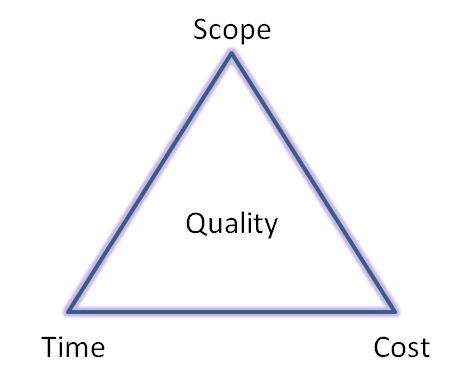The so-called classic constraints of the project, ie Fast, Economic and Inherent to the scope, are one of the major challenges of every project manager who must respect these three criteria during each work.
Specifically:
- Time: what is the deadline for delivering the output?
- Cost: what is the budget available to achieve this result?
- Scope: which is exactly the expected result?
CONTENT INDEX
The triple constraint of the projects
This triad is also called the triple costraint; if more is required for a given constraint, this will directly affect the other two.
Here is a simple example to understand why: if you decide to extend the scope and create 20 web pages instead of 10, you will logically need more time and money to reach the goal successfully.
The triple costraint is well known in project management environments and most of the literature states that once this is respected, the results will be guaranteed.
Often though, even if this triple costraint is balanced, the problems occur the same. Why?
Often PMs do not take into consideration the existence of further constraints, that should be optimized as well.
A project constraint is a defined or inflexible restriction on a project. All constraints are compromises.

An extended approach to constraints in project management
A project is often defined as successful if the goals of the project are achieved by the deadline and within the given budget.
But in addition to time, scope (or purpose of the project) and cost, there are six additional constraints that limit the process of achieving project goals. Let’s see which they are.
Quality costraint
Although this constraint is quite similar to scope costraint, there are actually differences.
The scope defines the exact result desired; in our example, the scope of the project is the creation of 10 web pages.
The quality focuses instead on the attributes of each of these pages.
It can be defined by answering the question: “How much does the result correspond to the initial expectations?”
In this example, therefore, quality does not define the number of web pages, but can be measured with other parameters.
It could be used as a criterion for evaluating the quality of the project, for example, the number of words on each page.
The request could be 1,000 words and the quality tolerance could be +/- 100 words.
So, if a web page contains 900 words it will be approved, if instead another web page contains only 850, this will be rejected.
In this case, it is evident how quality relates to the other constraints. For example, if the time is almost expired, the deadline can only be respected if the quality tolerance level is increased by accepting a number of words corresponding to 800 – because, in fact, writing further would mean not respecting the deadline.
Risk costraint
Risk management is an important task for project managers and any risk, needless to say, can have an impact – more or less serious – on the project.
For example, when preparing the website, you decide to skip the customer review step because you are late. In this way, there is a risk that the customer will reject the final pages precisely because he had no way, during the work, to give his feedback.
Of course, risk can be controlled to some degree through risk analysis, but contingencies are always around the corner during the entire life cycle of a project.
Resource costraint
Resources are closely connected to the cost of the project.
The amount of budget available to achieve the desired result will limit the use and acquisition of resources, which therefore creates a separate constraint.
Sometimes, even an infinite amount of money can not allow you to acquire the specific resources you need.
For example, it may take longer than expected to receive a physical resource that is essential for the design of web pages, such as an hardware, for example, which will consequently mean not respecting a deadline.
In this case, no amount of money could reduce delivery times and, for this, resources can be considered as a constraint on its own.
Sustainability costraint
The sustainability of a project can play an important role in an organization’s long-term strategy and can often influence the success of a project.
There are three types of sustainability: social, environmental and economic.
Although the first two do not generally apply directly to a project, the economic component should not be overlooked by the project managers.
Basically, managing the economic sustainability of a project refers to how the project manager manages its possible impact on the future of the organization in general.
For example, if you are working in an automobile production line, you can use low-cost materials to build some parts of the car in order to save costs.
However, in this way the economic sustainability of the organization could be sacrificed, as end consumers could complain and, consequently, choose competition’s products in the future.
Processes and organizational structures costraint
The organizational structure of a company can have a major impact on the success of the project, as it defines the project environment.
In fact, stakeholders could have a significant influence on the decisions that need to be taken.
Or again, the flow of communication that is too slow could lead to unexpected project decelerations.
Having therefore an efficient organizational structure behind a project means to have a constraint less.
Methodology costraint
Scrum, Agile, Kanban … Different project management methodologies can be used to work on a project.
Each of these methodologies has different limits.
If you use the Scrum methodology, you will have to organize daily meetings and receive numerous feedbacks and, consequently, invest in adequate resources to cover these efforts.
On the other hand, if you use the Agile methodology, it will generally be more difficult to estimate the time necessary to conclude a task in advance, which increases the risk of losing the deadline.
Therefore, to choose the right methodology, it is important to evaluate the specific situation of each project.
Customer satisfaction costraint
Customer satisfaction measures how much the customer’s expectations correspond to the final result of a project.
If the team has delivered excellent results on time and within the budget, the customer will most likely be happy and satisfied.
But if the cost turns out to be higher than expected, this would mean compromising in order to reach a level of satisfaction, at least sufficient, on the part of the customer.
Customer satisfaction will greatly influence the success of the project and it is therefore possible to consider it as a separate constraint.
To conclude, it is essential to know the different constraints of a project. The only way to control them is to understand them.
Therefore, when working on a project and, above all, when making important decisions about it, the project manager will not have to consider only the time, scope and budget, but also the quality, risk, resource, sustainability, organizational structure, methodology, and customer satisfaction factors.




